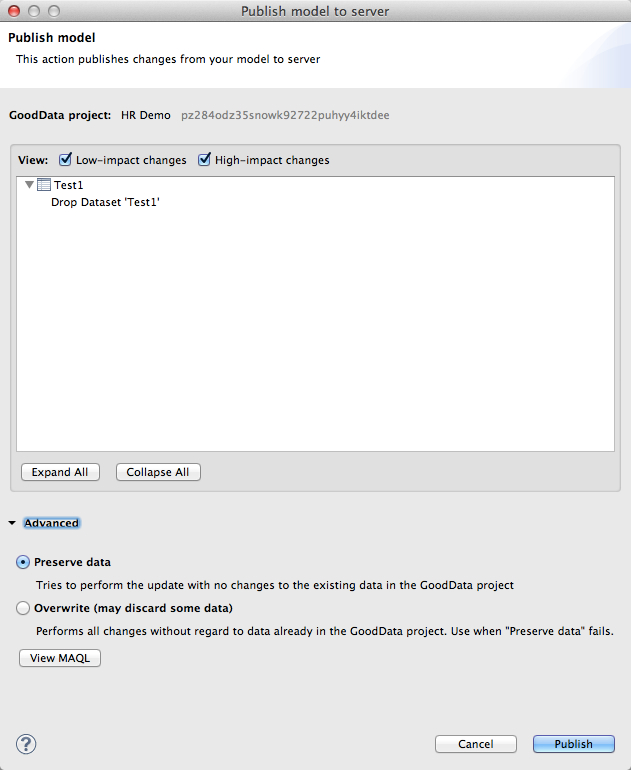Managing LDM Project Changes in CloudConnect
CloudConnect is a legacy tool and will be discontinued. We recommend that to prepare your data you use the GoodData data pipeline as described in Data Preparation and Distribution. For data modeling, see Data Modeling in GoodData to learn how to work with Logical Data Modeler.
After you have published your LDM to one or more projects on the server, you must re-publish it to each affected project whenever you make changes to it. Otherwise, the changes are not applied to your GoodData project. Depending on the changes, however, the updates may cause cascading deletes of project objects, which are no longer valid in the updated model. For more information, see Managing LDM Dependencies in CloudConnect.
Your logical data model can be published into a GoodData project that already contains some LDM components. When the model is published to the platform, the LDM Modeler inspects the existing LDM and tries to merge the new LDM changes into it.
Some changes to a logical data model can cause significant changes to the GoodData projects that use it. Before you publish your changes, see Recommendations for Changing LDM Objects.
To show only the high-impact changes, select the High-impact changes checkbox and deselect the Low-impact changes checkbox.
By default, CloudConnect attempts to preserve the data on the platform. To review data management options, click the Advanced options.
- To preserve the data in the project while the logical data model is being updated, click the Preserve data checkbox.
- If it is OK to delete the existing data in the project, choose to overwrite the data model. Click the Overwrite checkbox.
Use this option only if you want to clean the data from your project. To rebuild the project to its previous state, reload all ETL jobs that have already been posted to the project.
Recommendations for Changing LDM Objects
In general, changes that are unlikely to cause problems include adding fields to a dataset.
Removing a field is almost always a high-impact change, since multiple metrics and reports may be using the removed item.
If you are removing objects from your data model, which has already been published to a GoodData project, a different workflow and additional steps may be required. See Managing LDM Dependencies in CloudConnect.Changing the type of a field is a high-impact change that may cause data loss in the project.
General Tips:
When making changes to your logical data model, you should track the objects that have been modified from the previous version. Through the Manage page in the GoodData Portal, you can identify the other GoodData project objects that use these modified objects, which may be negatively impacted by these changes. For more information on this process, see Managing LDM Dependencies in CloudConnect.
When moving objects, do not delete from the source dataset and add again in the destination dataset. All references to the old object are lost. Instead, click and drag the object to the new dataset.
In general, make small changes to your data model and validate. See Validating Your Data Model in CloudConnect.
You can also test the effects of these changes. When you publish to the server, you are provided information on which changes are high-impact and are therefore likely to cause data loss. Back out of publishing these changes if you are unsure or uncomfortable with the effects. For more information, contact GoodData Customer Support.
